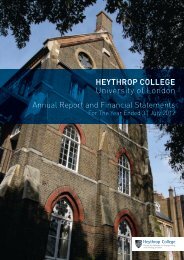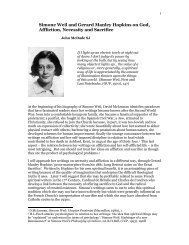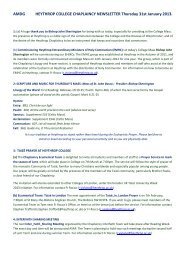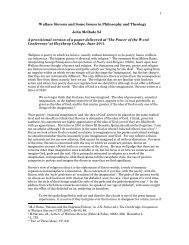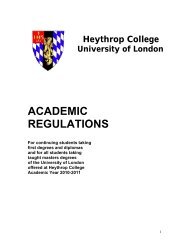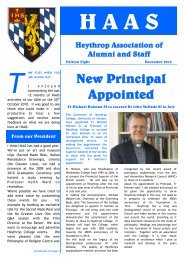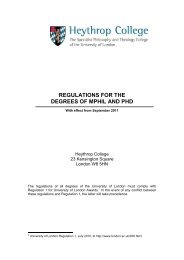Von Balthasar and the Office of Peter in the Church
Von Balthasar and the Office of Peter in the Church
Von Balthasar and the Office of Peter in the Church
Create successful ePaper yourself
Turn your PDF publications into a flip-book with our unique Google optimized e-Paper software.
12<br />
by <strong>the</strong> Pontifical Council for Inter-Religious Dialogue <strong>and</strong> his speeches on<br />
Jewish-Christian relations are <strong>in</strong> advance <strong>of</strong> most <strong>of</strong> <strong>the</strong> rest <strong>of</strong> <strong>the</strong> <strong>Church</strong>. In<br />
<strong>the</strong>se areas, he exemplifies a creative engagement -- genu<strong>in</strong>ely Paul<strong>in</strong>e, I th<strong>in</strong>k<br />
-- with <strong>the</strong> spectrum to be found <strong>in</strong> <strong>the</strong> contemporary religious Areopagus.<br />
The pr<strong>in</strong>ciples <strong>in</strong> <strong>the</strong> Fourfold <strong>Office</strong> should be directed, <strong>Balthasar</strong> judges,<br />
towards what he calls „<strong>the</strong> eschatological centre <strong>of</strong> gravity <strong>of</strong> <strong>the</strong> Gospel <strong>of</strong><br />
Christ‟, a dense phrase whose mean<strong>in</strong>g is difficult to discern. (329). I take it<br />
mean that <strong>the</strong> Fourfold <strong>Office</strong> must aim at giv<strong>in</strong>g <strong>the</strong> most complete form <strong>of</strong><br />
witness to God‟s unsurpassable self-gift <strong>in</strong> Christ, <strong>and</strong> must settle for noth<strong>in</strong>g<br />
less than this. In which case, it is <strong>the</strong> Johann<strong>in</strong>e pr<strong>in</strong>ciple, <strong>the</strong> ideal <strong>of</strong><br />
hol<strong>in</strong>ess <strong>and</strong> unitive love for Christ, towards which <strong>the</strong> <strong>in</strong>teraction <strong>of</strong> <strong>the</strong> o<strong>the</strong>r<br />
three pr<strong>in</strong>ciples must be directed. (John, after all, is <strong>the</strong> po<strong>in</strong>t <strong>of</strong> contact<br />
between Marian hol<strong>in</strong>ess <strong>and</strong> Petr<strong>in</strong>e authority.) The goal <strong>of</strong> <strong>the</strong> Fourfold<br />
<strong>Office</strong> is <strong>the</strong> hol<strong>in</strong>ess <strong>of</strong> <strong>the</strong> <strong>Church</strong>. Consequently, <strong>the</strong> Petr<strong>in</strong>e <strong>of</strong>fice is to be<br />
directed towards enabl<strong>in</strong>g <strong>the</strong> <strong>Church</strong> to embody Johann<strong>in</strong>e love <strong>and</strong><br />
hol<strong>in</strong>ess, <strong>and</strong> it must do this with an eye on what comes both from <strong>the</strong><br />
Jamesian pr<strong>in</strong>ciple <strong>of</strong> tradition <strong>and</strong> from <strong>the</strong> Paul<strong>in</strong>e pr<strong>in</strong>ciple <strong>of</strong><br />
adaptation. Sometimes <strong>the</strong> Fourfold <strong>Office</strong> discerns easily what teach<strong>in</strong>g to<br />
give <strong>in</strong> order to foster love <strong>and</strong> hol<strong>in</strong>ess, but not always:<br />
... <strong>the</strong>re are cases where it is extremely difficult to weigh <strong>the</strong> reasons for<br />
<strong>and</strong> aga<strong>in</strong>st, particularly when one tries to keep <strong>in</strong> m<strong>in</strong>d <strong>the</strong> „eschatological<br />
centre <strong>of</strong> gravity‟, not only because some current situation did not exist <strong>in</strong><br />
<strong>the</strong> period <strong>of</strong> biblical revelation, which means that conclusions have to be<br />
drawn from <strong>the</strong> spirit <strong>of</strong> a unique historical past <strong>and</strong> applied to a very<br />
different present, but also because Christ‟s <strong>Church</strong> conta<strong>in</strong>s a wide<br />
spectrum <strong>of</strong> human possibilities or obstructions, at <strong>the</strong> same time<br />
contribut<strong>in</strong>g to <strong>and</strong> detract<strong>in</strong>g from a perfect human response to <strong>the</strong><br />
perfect grace <strong>of</strong> God <strong>in</strong> Christ... A decision that is justifiable for those<br />
whose love is alive might be impractical for <strong>the</strong> lukewarm... on <strong>the</strong> o<strong>the</strong>r<br />
h<strong>and</strong>, a decision made to suit <strong>the</strong>se latter could seriously endanger <strong>the</strong><br />
balance <strong>of</strong> <strong>the</strong> <strong>Church</strong>‟s eschatological response, <strong>the</strong> ideal <strong>of</strong> those who love<br />
(329).<br />
This is precisely <strong>the</strong> situation <strong>of</strong> Humanae Vitae, he says, <strong>the</strong> most<br />
controversial <strong>in</strong>stance <strong>of</strong> recent papal teach<strong>in</strong>g, <strong>in</strong> which <strong>the</strong> Pope opted to<br />
po<strong>in</strong>t <strong>the</strong> <strong>Church</strong>‟s teach<strong>in</strong>g towards <strong>the</strong> latter (Johann<strong>in</strong>e) ideal <strong>and</strong>,<br />
consequently, to <strong>of</strong>fer <strong>the</strong> more difficult teach<strong>in</strong>g on marital sexuality.<br />
<strong>Balthasar</strong> presents <strong>the</strong> case <strong>of</strong> Humanae Vitae as a contemporary paradigm <strong>of</strong><br />
<strong>the</strong> function<strong>in</strong>g <strong>of</strong> <strong>the</strong> Fourfold <strong>Office</strong>: „though empowered <strong>and</strong> obliged to take<br />
<strong>the</strong> f<strong>in</strong>al, personal responsibility alone, <strong>the</strong> pope is directed to share <strong>in</strong> a<br />
dialogue with <strong>the</strong> o<strong>the</strong>r three partners <strong>of</strong> <strong>the</strong> “foursome”‟ (330-1). The<br />
problem, <strong>Balthasar</strong> says, has to do with <strong>the</strong> form <strong>of</strong> <strong>the</strong> teach<strong>in</strong>g (an encyclical<br />
which bound <strong>the</strong> consciences <strong>of</strong> married Catholics) ra<strong>the</strong>r than its content:<br />
„this resulted <strong>in</strong> a crisis for <strong>the</strong> more recent trend which had endeavoured to<br />
mask <strong>the</strong> exercise <strong>of</strong> authority‟ (330). <strong>Balthasar</strong> challenges nei<strong>the</strong>r <strong>the</strong><br />
decision made by Pope Paul VI to issue <strong>the</strong> encyclical nor its (non-<strong>in</strong>fallible)<br />
content, but he wonders whe<strong>the</strong>r ano<strong>the</strong>r, less decisive response might not<br />
have been as effective:



